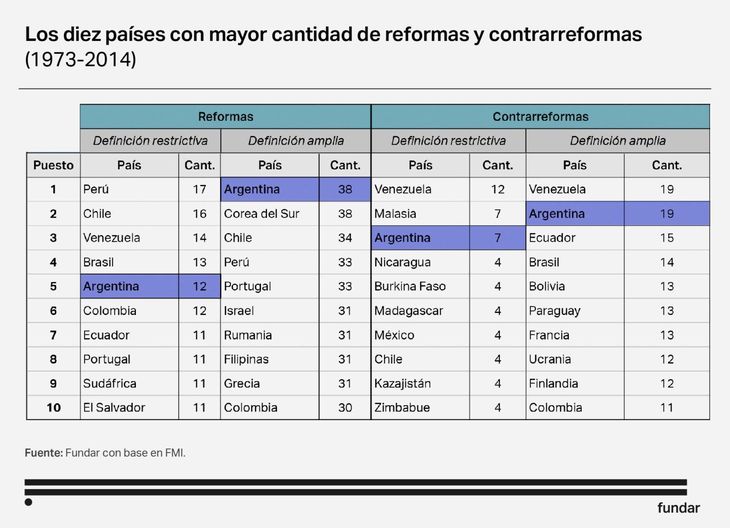For this reason, It is a mistake to attribute positive or negative macroeconomic effects per se to structural reforms. To understand what effect this type of reforms can have in today’s Argentina, it is key to return to the cases in which they were carried out, taking into account the contexts and starting points as well as the effects of their implementation.
The experience in Latin America
In the late 1980s and early 1990s, a large number of low- and middle-income countries undertook structural reformsstriving to reduce state intervention and take advantage of the opportunities offered by international markets.
In almost all countries, the reforms were effective in boosting exports, attracting foreign investment and increasing productivity in “cutting-edge” sectors. But in the case of Latin America, economic growth remained low and volatile, while domestic savings and investment remained at depressed levels. While some sectors highly integrated into the global economy expanded, the benefits did not always spread to the rest of the economy. This dualism generated adverse effects on the distribution of income, weakening the impact of growth on poverty reduction.
Despite their reformist efforts, Latin American countries—with some exceptions such as Chile— failed to accelerate their economic growth at a sufficient level to get closer to developed countries, even to prevent the gap from further widening.
reforms.jpg
The miracle of Southeast Asia
Southeast Asian countries not only adopted structural reforms more cautiously and gradually, but also relied on a broader set of tools, including industrial policy, with much better results. With the exception of specific cases such as the Philippines, in Southeast Asia, the reforms were adopted in a more cautious manner and without breaking the productive development scheme, which allowed maintain an uninterrupted convergence process.
While in Latin America structural reforms were adopted in a desperate attempt to deal with the negative repercussions of the debt crisis of the 1980s, in the context of a very fragile macroeconomy, structural reforms in Asia tended to reinforce the strategy of development in force during the second part of the 20th century.
The Argentine case (reforms 1.0)
reforms 2.jpg

If we look at the countries that implemented the most reforms and counter-reforms since 1973, Argentina has a prominent place. In the country, the concept of structural reforms burst into the discussion in a context of hyperinflation and overindebtedness. During the end of the Alfonsín government (1983-1989) and the beginning of the Menem government (1989-1999), the country faced one of the most ambitious reform programs, including a significant commercial and financial opening, and the privatization of public companies and the pension system.
As we saw in the regional analysis, the structural reforms adopted during the 1990s (the “1.0 reforms”) had some success in helping dynamic sectors and certain types of companies to access better and cheaper capital inputs and newer technologies. , as well as to diversify and expand internationally. However, by hindering the development of labor-intensive sectors, these processes were characterized by falls in employment and worsening income distribution.
What do these cases tell us?
The experience illustrates an important point when evaluating the results of structural reforms. The effects of structural reforms should not be confused with those of macroeconomic stabilization policies. At first glance, stabilization programs and the adoption of reforms seem to go hand in hand. But, as these experiences show, Adopting structural reforms does not guarantee satisfactory economic performance.
Structural reforms do not necessarily improve the macroeconomic performance of a country. However, the lack of reforms should not have an unconditionally positive assessment either. As we saw in the comparative analysis, the reform agenda is an accessory that can, at best, assist the country in achieving its objectives.
Economic development depends on structural characteristics that include issues such as capital accumulation, improved quality of infrastructure, a thriving national innovation system, and a healthy and well-educated population, among others. Stabilizing the economy and shoring up structural characteristics must come before any discussion of structural reforms. It can be achieved with very different degrees of state intervention, without the need to embrace all the reforms.
In short, deregulate aggressively, as happened in Latin America, no guarantee the adoption of an economic model that combines macroeconomic stability with insertion in global value chains that allows sustainable improvements in the living standards of the majority. Therefore, it is essential that Argentina focuses on stabilization and identifying a development strategy before reforming.
Keys to addressing new structural reforms
In order to think about an agenda of “reforms 2.0” for Argentina that draws on international evidence and the experience of our country, a series of dimensions to take into account are listed below.
Structural reforms can complement, but never replace, well-designed macroeconomic policy. Macroeconomic stability produces much more significant effects on variables such as inflation, growth, income distribution, poverty or employment.
The reforms are not an end in themselves, but a means to strengthen the structural characteristics of an economy. These are what determine the possibilities of economic growth and improvement of living conditions. The development of dynamic economic activities is not a spontaneous result of deregulated and open economies, and there is a risk that other important economic sectors will be seriously harmed. For reforms to be successful, they must be complemented by consistent macroeconomic policies and sectoral and social assistance policies.
Caution is essential when introducing them, particularly when it comes to measures such as trade or financial liberalization. In the past, its hasty adoption implied an excessive accumulation of external debt that led to financial crises, and an increase in unemployment that increased informality and poverty.
It is desirable that the reform programs be designed domestically and that their formulation be clear in relation to the essential and secondary aspects. An overly ambitious package inhibits the search for consensus on fundamental issues and creates greater risks of a subsequent reversal.
Source: Ambito
David William is a talented author who has made a name for himself in the world of writing. He is a professional author who writes on a wide range of topics, from general interest to opinion news. David is currently working as a writer at 24 hours worlds where he brings his unique perspective and in-depth research to his articles, making them both informative and engaging.




